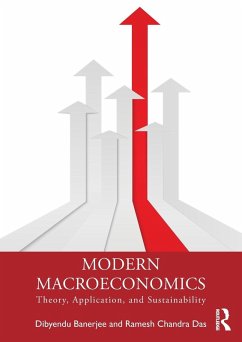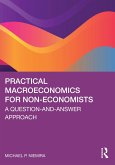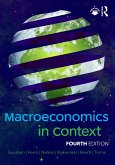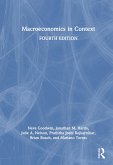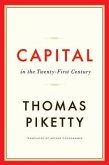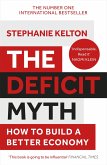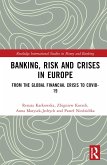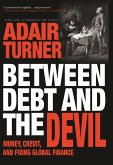Dibyendu Banerjee, Ramesh Chandra Das (Vidyasagar University, West Bengal, India)
Modern Macroeconomics
Theory, Application, and Sustainability
Dibyendu Banerjee, Ramesh Chandra Das (Vidyasagar University, West Bengal, India)
Modern Macroeconomics
Theory, Application, and Sustainability
- Broschiertes Buch
- Merkliste
- Auf die Merkliste
- Bewerten Bewerten
- Teilen
- Produkt teilen
- Produkterinnerung
- Produkterinnerung
This comprehensive textbook deals with multidimensional aspects of macroeconomics through lucid presentation of concepts and critical comparison of different schools of thoughts. It explains how the incomes of a country, prices of goods and services, level of employment, interest rates and so on are determined and how an economy progresses.
Andere Kunden interessierten sich auch für
![Practical Macroeconomics for Non-Economists Practical Macroeconomics for Non-Economists]() Michael P. NiemiraPractical Macroeconomics for Non-Economists59,99 €
Michael P. NiemiraPractical Macroeconomics for Non-Economists59,99 €![Macroeconomics in Context Macroeconomics in Context]() Neva Goodwin (USA. Tufts University)Macroeconomics in Context139,99 €
Neva Goodwin (USA. Tufts University)Macroeconomics in Context139,99 €![Macroeconomics in Context Macroeconomics in Context]() Neva Goodwin (USA. Tufts University)Macroeconomics in Context205,99 €
Neva Goodwin (USA. Tufts University)Macroeconomics in Context205,99 €![Capital in the Twenty-First Century Capital in the Twenty-First Century]() Thomas PikettyCapital in the Twenty-First Century35,99 €
Thomas PikettyCapital in the Twenty-First Century35,99 €![The Deficit Myth The Deficit Myth]() Stephanie KeltonThe Deficit Myth11,99 €
Stephanie KeltonThe Deficit Myth11,99 €![Banking, Risk and Crises in Europe Banking, Risk and Crises in Europe]() Renata KarkowskaBanking, Risk and Crises in Europe177,99 €
Renata KarkowskaBanking, Risk and Crises in Europe177,99 €![Between Debt and the Devil Between Debt and the Devil]() Adair TurnerBetween Debt and the Devil25,99 €
Adair TurnerBetween Debt and the Devil25,99 €-
-
-
This comprehensive textbook deals with multidimensional aspects of macroeconomics through lucid presentation of concepts and critical comparison of different schools of thoughts. It explains how the incomes of a country, prices of goods and services, level of employment, interest rates and so on are determined and how an economy progresses.
Hinweis: Dieser Artikel kann nur an eine deutsche Lieferadresse ausgeliefert werden.
Hinweis: Dieser Artikel kann nur an eine deutsche Lieferadresse ausgeliefert werden.
Produktdetails
- Produktdetails
- Verlag: Taylor & Francis Ltd
- Seitenzahl: 630
- Erscheinungstermin: 10. Dezember 2024
- Englisch
- Abmessung: 175mm x 248mm x 39mm
- Gewicht: 1100g
- ISBN-13: 9781032817361
- ISBN-10: 1032817364
- Artikelnr.: 71234189
- Herstellerkennzeichnung
- Libri GmbH
- Europaallee 1
- 36244 Bad Hersfeld
- gpsr@libri.de
- Verlag: Taylor & Francis Ltd
- Seitenzahl: 630
- Erscheinungstermin: 10. Dezember 2024
- Englisch
- Abmessung: 175mm x 248mm x 39mm
- Gewicht: 1100g
- ISBN-13: 9781032817361
- ISBN-10: 1032817364
- Artikelnr.: 71234189
- Herstellerkennzeichnung
- Libri GmbH
- Europaallee 1
- 36244 Bad Hersfeld
- gpsr@libri.de
Dibyendu Banerjee is currently Associate Professor of Economics at Serampore College, West Bengal, India; with 21 years of teaching and research experience in various fields of the subject. He completed his Bachelor (Hons.) of economics at R. K. Mission, Narendrapur, West Bengal; and his master's degree at University of Calcutta. He obtained his doctorate from the same university, working under the supervision of Professor Sarbajit Chaudhuri. He started his career as a lecturer in economics at A. K. P. C. Mahavidyalaya, Hooghly. Dr. Banerjee, with his specialisation in advanced economic theory, has contributed several research papers to many renowned national and international journals such as Research in Economics, Economic Modelling, International Review of Economics, and Finance. He has coauthored a textbook titled Macroeconomics: From Short Run to Long Run. His current research interests include labour economics, development economics, competitive general equilibrium models, and applied microeconomics. Ramesh Chandra Das is currently Professor at the Department of Economics of Vidyasagar University in the state of West Bengal, India. He has obtained his master's, M. Phil, and PhD degrees in economics from the University of Calcutta. Prof. Das has the teaching and research experience of about 25 years to his credit. His main areas of research lie in theoretical and applied macroeconomics, financial economics, environmental economics and political economics. He has contributed more than 100 research papers to national and international journals and books along with more than a dozen edited volumes in different areas of the subject. Besides, he has written text and reference books on microeconomics, macroeconomics, and banking economics with internationally reputed publishers for different fields of readers and academicians and has been acting as the editor-in-chief of a couple of refereed journals.
Part I: Macroeconomics- Objectives, Instruments, Concepts and Phases of
Developments 1. Why to study macroeconomics and what are its objectives?
2. National Income Accounting Part II: Classical School of Thought-The Long
Run Supply Side Model 3. Classical model 4. Money, quantity theory and
price level 5. Theory of inflation Part III: Modern Macroeconomics-The
Keynesian Short Run Demand Side Models 6. The Simple Two Sector
Economy-Simple Keynesian Model without Government-Model I 7. Introduction
of Government Sector into the Simple Keynesian Model- Model II 8. Product
Market Equilibrium- Model III 9. Money Market Equilibrium -Model IV 10.
Interactions of Fiscal and Monetary Policies in IS-LM Models- Model V 11.
Aggregate Demand and Aggregate Supply Analysis 12. Aggregate Supply,
Inflation and Phillips Curve 13. The Complete Keynesian Model (CKM) Part
IV: Micro Foundations of Macroeconomics-The Consumption and Investment
Behaviours 14. Consumption function 15. Investment behaviour 16. Demand for
money 17. Theory of money supply 18. Schools of thoughts in macroeconomics
Part V: Open Economy Macroeconomics 19. Open Economy
Macroeconomics-Concepts and Applications 20. Accounting of International
Linkages-The Balance of Payments 21. Interactions among Commodity Market,
Money Market and External Market Part VI: Economics of Growth and
Convergence-The Longer Run Models 22. Theories of Economic
Growth-Classical, Harrod and Domar 23. The Neoclassical Growth Model 24.
Endogenous Growth Theories-The Modern Growth Approach Part VII: Sustainable
Development and Green Macroeconomics 25. Sustainable development 26.
Ecological macroeconomics
Developments 1. Why to study macroeconomics and what are its objectives?
2. National Income Accounting Part II: Classical School of Thought-The Long
Run Supply Side Model 3. Classical model 4. Money, quantity theory and
price level 5. Theory of inflation Part III: Modern Macroeconomics-The
Keynesian Short Run Demand Side Models 6. The Simple Two Sector
Economy-Simple Keynesian Model without Government-Model I 7. Introduction
of Government Sector into the Simple Keynesian Model- Model II 8. Product
Market Equilibrium- Model III 9. Money Market Equilibrium -Model IV 10.
Interactions of Fiscal and Monetary Policies in IS-LM Models- Model V 11.
Aggregate Demand and Aggregate Supply Analysis 12. Aggregate Supply,
Inflation and Phillips Curve 13. The Complete Keynesian Model (CKM) Part
IV: Micro Foundations of Macroeconomics-The Consumption and Investment
Behaviours 14. Consumption function 15. Investment behaviour 16. Demand for
money 17. Theory of money supply 18. Schools of thoughts in macroeconomics
Part V: Open Economy Macroeconomics 19. Open Economy
Macroeconomics-Concepts and Applications 20. Accounting of International
Linkages-The Balance of Payments 21. Interactions among Commodity Market,
Money Market and External Market Part VI: Economics of Growth and
Convergence-The Longer Run Models 22. Theories of Economic
Growth-Classical, Harrod and Domar 23. The Neoclassical Growth Model 24.
Endogenous Growth Theories-The Modern Growth Approach Part VII: Sustainable
Development and Green Macroeconomics 25. Sustainable development 26.
Ecological macroeconomics
Part I: Macroeconomics- Objectives, Instruments, Concepts and Phases of
Developments 1. Why to study macroeconomics and what are its objectives?
2. National Income Accounting Part II: Classical School of Thought-The Long
Run Supply Side Model 3. Classical model 4. Money, quantity theory and
price level 5. Theory of inflation Part III: Modern Macroeconomics-The
Keynesian Short Run Demand Side Models 6. The Simple Two Sector
Economy-Simple Keynesian Model without Government-Model I 7. Introduction
of Government Sector into the Simple Keynesian Model- Model II 8. Product
Market Equilibrium- Model III 9. Money Market Equilibrium -Model IV 10.
Interactions of Fiscal and Monetary Policies in IS-LM Models- Model V 11.
Aggregate Demand and Aggregate Supply Analysis 12. Aggregate Supply,
Inflation and Phillips Curve 13. The Complete Keynesian Model (CKM) Part
IV: Micro Foundations of Macroeconomics-The Consumption and Investment
Behaviours 14. Consumption function 15. Investment behaviour 16. Demand for
money 17. Theory of money supply 18. Schools of thoughts in macroeconomics
Part V: Open Economy Macroeconomics 19. Open Economy
Macroeconomics-Concepts and Applications 20. Accounting of International
Linkages-The Balance of Payments 21. Interactions among Commodity Market,
Money Market and External Market Part VI: Economics of Growth and
Convergence-The Longer Run Models 22. Theories of Economic
Growth-Classical, Harrod and Domar 23. The Neoclassical Growth Model 24.
Endogenous Growth Theories-The Modern Growth Approach Part VII: Sustainable
Development and Green Macroeconomics 25. Sustainable development 26.
Ecological macroeconomics
Developments 1. Why to study macroeconomics and what are its objectives?
2. National Income Accounting Part II: Classical School of Thought-The Long
Run Supply Side Model 3. Classical model 4. Money, quantity theory and
price level 5. Theory of inflation Part III: Modern Macroeconomics-The
Keynesian Short Run Demand Side Models 6. The Simple Two Sector
Economy-Simple Keynesian Model without Government-Model I 7. Introduction
of Government Sector into the Simple Keynesian Model- Model II 8. Product
Market Equilibrium- Model III 9. Money Market Equilibrium -Model IV 10.
Interactions of Fiscal and Monetary Policies in IS-LM Models- Model V 11.
Aggregate Demand and Aggregate Supply Analysis 12. Aggregate Supply,
Inflation and Phillips Curve 13. The Complete Keynesian Model (CKM) Part
IV: Micro Foundations of Macroeconomics-The Consumption and Investment
Behaviours 14. Consumption function 15. Investment behaviour 16. Demand for
money 17. Theory of money supply 18. Schools of thoughts in macroeconomics
Part V: Open Economy Macroeconomics 19. Open Economy
Macroeconomics-Concepts and Applications 20. Accounting of International
Linkages-The Balance of Payments 21. Interactions among Commodity Market,
Money Market and External Market Part VI: Economics of Growth and
Convergence-The Longer Run Models 22. Theories of Economic
Growth-Classical, Harrod and Domar 23. The Neoclassical Growth Model 24.
Endogenous Growth Theories-The Modern Growth Approach Part VII: Sustainable
Development and Green Macroeconomics 25. Sustainable development 26.
Ecological macroeconomics

